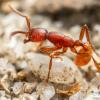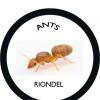1. Location of collection -- caught in Jakarta on a wall in a balcony. It would definitely be counted as a city, with perhaps a few empty gardens/lots. it did not try to escape in any way when caught, but walked round the area calmly before settling near some cotton.
2. Date of collection -- 9 November, 12PM (noon)
3. Habitat of collection -- house/residential area
4. Length -- 11.5mm for the queen and about 6mm for the workers (can refer to the image because I measured from head to gaster excluding antennae)
5. Coloration -- queen is almost purely black excluding her legs and gaster which are very slightly brown under light. queen is very shiny. workers are much more brownish color, with a dark brown head and lighter brown thorax and gaster. (image below)
6. Distinguishing characteristics -- one petiole node, no noticeable spines or bumps on the body and a relatively large flat head with big mandibles and bent antennae. workers are similar just slightly slimmer heads presumably because they are minors?
7. Behavior -- relatively calm under light, especially the queen; workers may get a little shocked when first introduced to light but quickly settle. large vibrations with disturb them greatly though. queen is rather adventurous/active, checking out food area. extremely stubborn when it comes to moving test tubes.
*i think it's important to note that the queen laid orange eggs which later developed into the workers seen. will try to get more clearer pictures when macro lenses arrive
8. pictures!
or
https://drive.google...nxB?usp=sharing(these contain multiple pictures)
thank you in advance everyone ![]()
Edited by eclaires, December 27 2022 - 2:18 AM.















